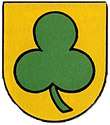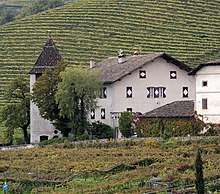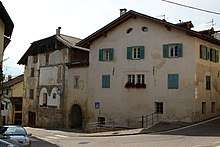In der Maur
In der Maur (also written as In der Mauer, Indermaur and Indermauer) is an ancient armigerous family of Swiss origin. Throughout the Middle Ages and Renaissance, the In der Maur family held positions of regional administrative authority in the government of Farniwang, later known as Berneck, St. Gallen. A branch of the family living in South Tyrol, von In der Maur auf Strelburg und zu Freifeld, was elevated into the ranks of the lower nobility within the Holy Roman Empire and the Kingdom of Bavaria. Prominent members of the family include the Swiss artist Robert Indermaur and the Austrian statesman Carl von In der Maur, who served as Governor of Liechtenstein.
.png)
| In der Maur In der Mauer | |
|---|---|
| Burgher family (in Switzerland) noble family (in Austria) | |
 Green cloverleaf in gold, the Escutcheon of the In der Maurs of Berneck (from 1478) | |
| Country | |
| Place of origin | Rhaetian Alps, Switzerland |
| Titles |
|
| Connected families | |
| Traditions | Roman Catholicism Swiss Reformed Protestantism |
| Estate(s) | Strehlburg Freienfeld |
History
The In der Maur family originated in the Rhaetian Alps in Switzerland during the Middle Ages, descending from the Alemanni. The surname, from the German language, translates to "in the wall", possibly referring to a fortress, defensive wall, or a geographic moor.[1] The main branches of the family settled within the territory of the Holy Roman Empire that is now Eastern Switzerland, Southern Austria and Northern Italy.
Austrian branch
In 1479 the In der Maurs who had settled in Habsburg-ruled South Tyrol[2] were granted a coat of arms by Frederick III of the Holy Roman Empire. On 23 October 1491 they were granted another coat of arms by Maximilian II. A third coat of arms was granted to six brothers and three male cousins of the family on 1 August 1586 in Innsbruck.[3] On 6 March 1601 the In der Maurs were elevated to the landed nobility by Rudolf II. On 23 June 1703 the In der Maurs were made barons by Leopold I.[4][5][6] The In der Maurs, as part of the Tyrolese lower nobility, owned a schloss and various Ansitze in Kurtatsch an der Weinstraße and Freienfeld.[7][8] In 1615 Caspar Indermaur funded the construction of the Catholic Chapel of St. Anna at Ansitz Strehlburg, one of the In der Maur estates in Kurtatsch.[9][10][11]

On 19 October 1813 in Munich, Josef Sebastian Anton Indermauer von Freifeld zu Strelburg was granted noble status as a briefadel in the Kingdom of Bavaria through letters patent from Maximilian I Joseph of Bavaria.[12]
The Austrian In der Maurs included the nobiliary particles von (descending from) and zu (resident at) in their surname as von In der Maur auf Strehlburg und zu Freienfeld, referencing two of their principal estates, Strehlburg and Freienfeld, in South Tyrol. The use of nobiliary particles in the surname was maintained until the nobility was abolished in Austria in 1919 and the use of nobiliary particles in the surname became illegal.
Swiss branch
During the Medieval period the In der Maurs were elevated to the burgher class and granted the right to use heraldry. As members of the privileged class, they were permitted to live in fortified stone houses, instead of wooden houses that were typical of the peasant class. Throughout the Middle Ages and into the early Renaissance period, the In der Maurs served in administrative roles in the government of Farniwang (later called Berneck) as Landamänner, or chief magistrates of the rural Landsgemeinde.[13] They continued having political and economic influence in the region after the Abbey of Saint Gall gained control, having been granted privileges by the Prince-Abbots of St. Gallen.[14][15][16] In 1525, Berneck's population, facing political pressure, converted from Catholicism to Protestantism. By 1532, more than half of the residents had returned to their original religion. The In der Maurs of Berneck, who had adopted the religious reforms of Huldrych Zwingli during the Reformation and became Protestant, chose to remain in the Reformed faith.[17][18]
In 1590 Hans Indermaur, a tanner from Berneck, resettled in Rheineck.[19][15] Indermaur's house was purchased in the 1700s by the municipality of Rheineck and was converted into an orphanage. The building is now a historic landmark and the house's cellar, once used as a tannery, is now a performance venue.[20]
A restaurant in Rorschach, Zum goldenen Fass, was started by Johann Indermaur of Berneck in 1905 and is still owned and operated by the family.[21] The family owns the Maienhalde estate, a winery and vineyard in Berneck.[22][23] The family also owned a furniture manufacturing company in Goldach for 105 years.[24]
Dutch line
In the middle of the eighteenth century Paulus In der Maur of Berneck (1732–1805) moved from Switzerland to Schoonhoven, South Holland, the Netherlands, thus creating a Dutch branch of the family.[25][16] His descendants later settled in Utrecht, Gouda, Rotterdam, and Dordrecht. This line included two prominent organ builders, Johann Frederik In der Maur (1790–1836) and Johannes Casper In der Maur (1817–1860). Paulus In der Maur's great-grandson, George In der Maur (1831–1889), moved to Batavia, Dutch East Indies (present-day Jakarta, Indonesia), where he married and had seven children.[16][26]
English line
Johannes In der Maur of Berneck (b. 1748), son of Herman In der Mauer (b. 1719) and Anna Schreiberin, moved with his wife Margaretha Oberhausler from Switzerland to England. They had three children; Herman Indermaur (b. 1776), Anna Regula Indermaur (b. 1778), and Henry Indermaur (1788 –1848).[27] The English In der Maur line continued with descendants settling in Middlesex and Somerset. In 1952, Minnie Rose Carpenter (b. 1919) of Gillingham, the wife of David George Indermaur, departed from Southampton with her daughters Barbara Catherine Indermaur (b. 1944) and Jean Elizabeth Indermaur (b. 1949) to join her husband in Melbourne, Victoria, Australia.[28]
Notable family members
- Ignaz Anton von Indermauer (1759–1796), Vogt of Vorarlberg
- John Indermaur (1851–1925), English lawyer
- Carl von In der Maur (1852–1913), Governor of Liechtenstein
- Gilbert von In der Maur (1887–1959), leading member of the Austrian National Socialist Party
- Edna Indermaur (1892–1985), American opera singer
- Wolf In der Maur (1924–2005), Austrian journalist
- Robert Indermaur (b. 1947), Swiss painter and sculptor
- Mirjam Indermaur (b. 1967), Swiss businesswoman and writer
- Rahel Indermaur (b. 1980), Swiss opera singer
- David Indermaur, Australian psychologist
- Jan-Jaap In der Maur, Dutch businessman
- Rebecca Indermaur, Swiss actress
- Scott Indermaur, American photographer
Residences

- Ansitz Eberlehof, an Ansitz in Kurtatsch an der Weinstraße, Italy
- Finkenhof House, a fortified house in Kurtatsch an der Weinstraße, Italy
- Ansitz Fohrhof, an Ansitz in Kurtatsch an der Weinstraße, Italy
- Ansitz Freienfeld, an Ansitz in Kurtatsch an der Weinstraße, Italy
- Nokrische Behausung, a group of houses in Kurtatsch an der Weinstraße, Italy
- Ansitz Nussdorf, an Ansitz in Kurtatsch an der Weinstraße, Italy
- Schloss Nussegg, a castle in Kurtatsch an der Weinstraße, Italy
- Ansitz Strehlburg, an Ansitz in Kurtatsch an der Weinstraße, Italy
- Ansitz Baron von Widmann, an Ansitz in Kurtatsch an der Weinstraße, Italy
References
- Dixon 1857, p. 39.
- Traunsteiner, Joseph (1842). Monographie der Weiden von Tirol und Borarlberg (in German). Innsbruck: Wagner'schen Schriften. p. 53. OCLC 175304763.
- von Goldegg 1875, p. 122.
- https://archive.org/stream/neuesallgemeine11knesgoog/neuesallgemeine11knesgoog_djvu.txt
- Rietstap, Johannes Baptista (1875). Armorial général, contenant la description des armoiries des familles nobles et patriciennes de l'Europe: précédé d'un dictionnaire des termes du blason (in French). Amsterdam: G.T. Bom. p. 689.
- Südtiroler Unterland (2) 2017.
- Südtiroler Unterland 2017.
- Kurtatsch 2017.
- Abteilung Denkmalpflege 2006, p. 16.
- O. Maass' Söhne 1905, p. 327.
- Göldi, Johannes (1897). St. Gallische Gemeinde-Archive. 3 Der Hof Bernang (in German). St. Gallen.
- "Indermaur von Berneck SG". The Swiss Genealogical Heraldic Web Catalog. Retrieved 22 November 2018.
- "Historisches Lexikon der Schweiz (HLS)". hls-dhs-dss.ch.
- "Genealogieën :: In der Maur uit Berneck". genealogie.genealogie.joosen.org.
- Gemeinde Berneck 2017.
- "Geschichte – Ortsmuseum Berneck".
- "Hans INDERMAUR b. Abt 1570 of Rheineck, Sankt Gallen, Switzerland d. Yes, date unknown: YOUNG - HOGAN Family History". richardpyoung.org.
- Seiler 2010.
- Schneeberger, Valentin (18 July 2013). "Im "Fässli" gibt's kein Bier mehr". Tagblatt (in German). Retrieved 22 November 2018.
- "Maienhalde". Maienhalde. Retrieved 22 November 2018.
- "The Ostschweiz". epicurean-traveler.com. Retrieved 2020-01-30.
- Riedener, Jolanda. "VERÄNDERUNG: Möbelhaus muss weichen". St.Galler Tagblatt.
- "Paulus in der Maur". geni_family_tree.
- Nieuwsblad Voor Den Boekhandel. 54. Amsterdam. pp. 35, 590. OCLC 1696662.
- "Kohn Indermaur". www.ancestry.com. Retrieved 2020-01-30.
- "INDERMAUR". Western Australia Museum. Retrieved 22 November 2018.
Sources
- "Ansitz Freienfeld - No. 9". Tourist Board Südtiroler Unterland. Retrieved 26 June 2017.
- "Ansitz Nussdorf - No. 18" (in German). Tourist Board Südtiroler Unterland. Retrieved 27 June 2017.
- Dixon, B. Homer (1857). Surnames. Boston: John Wilson and Son. OCLC 796971010.CS1 maint: ref=harv (link)
- Europäischer Tag des Denkmals / Giornata Europea del Patrimonio (PDF) (in German and Italian), Bozen: Südtirol Abteilung Denkmalpflege, 24 September 2006
- Genealogisches Taschenbuch der adeligen Häuser Österreichs (in German). Vienna: O. Maass' Söhne. 1905. pp. 326–329. OCLC 47886155.
- von Goldegg, Hugo, ed. (1875). Die Tiroler Wappenbücher im Adelsarchive des k. k. Ministerium des Innern zu Wien (PDF) (in German). Innsbruck: Wagner. OCLC 495209343.
- "Pfarrgemeinde Kurtatsch". Seelsorgeeinheit Kurtatsch-Margreid-Kurtinig-Penon-Graun-Fennberg (in German). Retrieved 16 July 2017.
- Seiler, Maya (19 April 2010). "Magischen Ort geschaffen". St. Galler Tagblatt (in German). Rheineck. Retrieved 29 September 2017.CS1 maint: ref=harv (link)
- "Trennung in alten und neuen Glauben" (in German). Berneck: Gemeinde Berneck. Retrieved 16 July 2017.
Further reading
Veronika Gruber: Kurtatsch und sein Gebiet im Wandel der Zeit, Kurtatsch 1995 (German), online version: online